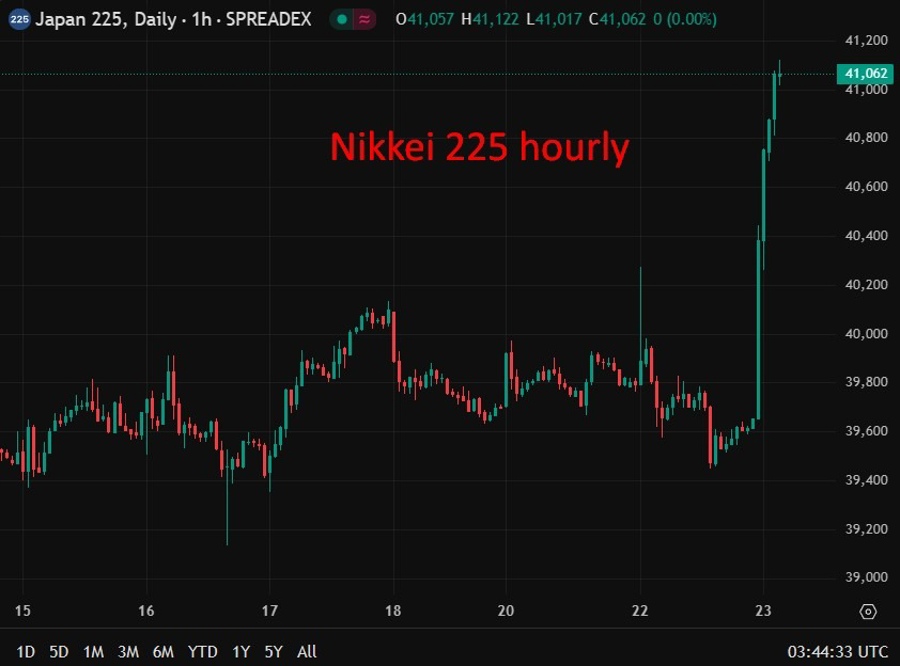Investinglive Asia-pacific FX news wrap: Japan Trade Deal Lifts Nikkei, JPY Choppy
Japan trade deal, as it unfolded:
- Trump reckons he has completed a 'massive deal' with Japan
- Trump says hes not lying this time, Japan deal is a 'lot different' from deals in the past
- US and Japanese equity index futures are higher on Trump's 'deal' with Japan
- Japan's Akazawa says 'Mission Complete'
- Japan and US agreed to 15% auto tariff according to NHK
- US 'big three' automakers oppose the Japan trade deal
- Japan Prime Minister Ishiba: Agreed with the U.S. on tariffs.
- Japan stocks - Nikkei has risen to its highest since 17 July 2024
- Trump admin official says Japan will buy more agricultural produce from US
- SMBC: Positive trade news will give only limited yen support amid political uncertainty
- Moody’s Analytics: Japan trade deal could deepen political strains in Tokyo
Bank of Japan Uchida:
- Bank of Japan deputy governor Uchida: Japan’s economy has recovered moderately
- More from Bank of Japan Deputy Governor Uchida
- More again from Bank of Japan Deputy Governor Uchida - CPI to dip then rise
- Bank of Japan Deputy Governor Shinichi Uchida - recap
- BOJ flags trade uncertainty, signals caution on further rate hikes
Other:
- China Lodges Protest Over EU Sanctions in High-Level Trade Talks
- A Japanese media outlet reports that PM Ishiba will resign by the end of August
- PBOC sets USD/ CNY mid-point today at 7.1414 (vs. estimate at 7.1596)
- Is PIMCO warning runaway US spending may trap Fed, as fiscal strains test monetary limits?
- Australia's "Leading Index continues to show stalling momentum"
- Australian regulator says will keep mortgage serviceability buffer, policy settings onhold
- Yen could face fresh storm as Japan vote fuels carry trade revival and BOJ policy doubts
- Japan’s Akazawa met with Trump on Tuesday
- Japan politics - PM Ishiba under resignation pressure, to meet with Aso, Kishida today
- OpenAI confirmed as Oracle’s US$30bn cloud client, fueling stock surge
- More on Goldman Sachs forecast for 3 consecutive 2025 Federal Reserve interest rate cuts.
- Investinglive Americas FX news wrap 22 Jul: USD continues its fall for 2nd day this week
- Japan’s Akazawa, US Treasury Sec Bessent held trade tariff talks for about 30 minutes
- Oil: private survey of inventory shows a headline crude oil draw smaller than expected
- Northrop Grumman do not believe current Trump tariffs will have material adverse effect
- NASDAQ winning streak ends. Alphabet rose for the 10th straight day. Earnings tomorrow.
- Trump Team Probes Fed Project as another TACO takes shape
- Trump will meet UK Prime Minister Starmer on the weekend - seeking trade deal
The big news today was the announcement from Trump of a U.S.-Japan trade deal. His initial tweet was met with some scepticism—understandable, given his track record of misleading markets on trade—but confidence rose after Japan’s chief tariff negotiator, Ryosei Akazawa, confirmed the agreement via social media.
Details are still emerging (see posts above), but in brief:
15% reciprocal tariffs
15% auto tariffs (down from a proposed 25%)
Metal tariffs (e.g., steel and aluminium) remain at 50%
No specifics yet on upcoming semiconductor or electronics tariffs
Japan won’t cut tariffs or "sacrifice agriculture"
Rules will be adjusted to increase rice imports
Japan will invest $550 billion into the United States
The most immediate market impact was seen in Japanese equities. The Nikkei 225 surged more than 2.5%, hitting its highest level since 17 July 2024. Shares of Japanese automakers led the rally. However, U.S. automakers pushed back. The Detroit Three criticised the deal as favouring Japan, noting that while tariffs are cut on vehicles exported from Japan, the same does not apply to Japanese cars built in North America. U.S. automakers still face:
50% steel tariffs
50% aluminium tariffs
50% copper tariffs
25% tariffs on imports from Canada
25% tariffs on imports from Mexico
Their grievances appear reasonable.
In Japanese political news, the Mainichi Shimbun reported that Prime Minister Shigeru Ishiba will step down by the end of August following his coalition’s defeat in the recent upper house election.
From the Bank of Japan, Deputy Governor Shinichi Uchida delivered a cautious economic outlook ahead of the BoJ’s 30–31 July policy meeting. Uchida flagged significant downside risks to growth and inflation due to “extremely high” global trade uncertainty. While the BoJ remains open to further rate hikes, any moves will depend on whether economic and price trends align with their projections.
Through it all, the yen saw choppy price action, trading in a wide 146.20–147.20 range. USD/JPY dipped (i.e., yen strengthened) on the initial trade headlines before bouncing back, dipping again, and bouncing again! As of this post, the pair is little changed from late U.S. session levels.
Elsewhere in FX, major currencies mostly traded in narrow ranges. The People’s Bank of China set USD/CNY at 7.1414—the strongest CNY fixing since 6 November last year.
Nikkei:




